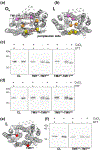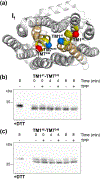The Multidrug Transporter MdfA Deviates from the Canonical Model of Alternating Access of MFS Transporters
- PMID: 32860775
- PMCID: PMC7541688
- DOI: 10.1016/j.jmb.2020.08.017
The Multidrug Transporter MdfA Deviates from the Canonical Model of Alternating Access of MFS Transporters
Abstract
The prototypic multidrug (Mdr) transporter MdfA from Escherichia coli efflux chemically- dissimilar substrates in exchange for protons. Similar to other transporters, MdfA purportedly functions by alternating access of a central substrate binding pocket to either side of the membrane. Accordingly, MdfA should open at the cytoplasmic side and/or laterally toward the membrane to enable access of drugs into its pocket. At the end of the cycle, the periplasmic side is expected to open to release drugs. Two distinct conformations of MdfA have been captured by X-ray crystallography: An outward open (Oo) conformation, stabilized by a Fab fragment, and a ligand-bound inward-facing (If) conformation, possibly stabilized by a mutation (Q131R). Here, we investigated how these structures relate to ligand-dependent conformational dynamics of MdfA in lipid bilayers. For this purpose, we combined distances measured by double electron-electron resonance (DEER) between pairs of spin labels in MdfA, reconstituted in nanodiscs, with cysteine cross-linking of natively expressed membrane-embedded MdfA variants. Our results suggest that in a membrane environment, MdfA assumes a relatively flexible, outward-closed/inward-closed (Oc/Ic) conformation. Unexpectedly, our data show that neither the substrate TPP nor protonation induces large-scale conformational changes. Rather, we identified a substrate-responsive lateral gate, which is open toward the inner leaflet of the membrane but closes upon drug binding. Together, our results suggest a modified model for the functional conformational cycle of MdfA that does not invoke canonical elements of alternating access.
Keywords: DEER; MdfA; conformational cycle; multidrug transport; nanodiscs.
Copyright © 2020 Elsevier Ltd. All rights reserved.
Figures








References
-
- Saier MH Jr., Eng BH, Fard S, Garg J, Haggerty DA, Hutchinson WJ, et al. Phylogenetic characterization of novel transport protein families revealed by genome analyses. Biochim Biophys Acta. 1999;1422:1–56. - PubMed
-
- Fluman N, Bibi E. Bacterial multidrug transport through the lens of the major facilitator superfamily. Biochim Biophys Acta. 2009;1794:738–47. - PubMed
-
- Yardeni EH, Zomot E, Bibi E. The fascinating but mysterious mechanistic aspects of multidrug transport by MdfA from Escherichia coli. Res Microbiol. 2017. - PubMed
-
- Sigal N, Vardy E, Molshanski-Mor S, Eitan A, Pilpel Y, Schuldiner S, et al. 3D model of the Escherichia coli multidrug transporter MdfA reveals an essential membrane-embedded positive charge. Biochemistry. 2005;44:14870–80. - PubMed
Publication types
MeSH terms
Substances
Grants and funding
LinkOut - more resources
Full Text Sources
Other Literature Sources
Molecular Biology Databases

